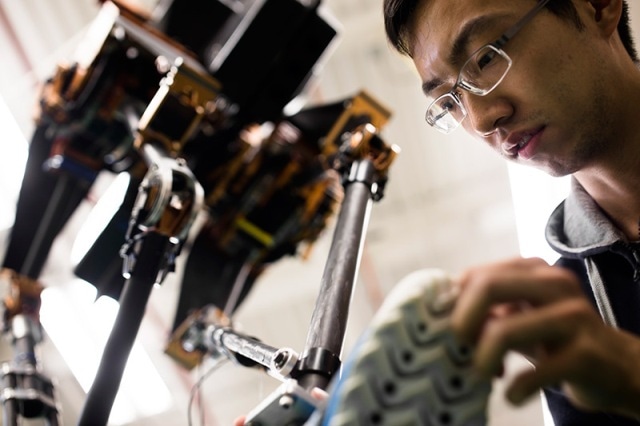May 9 2016
 (Credit: University of Michigan College of Engineering)
(Credit: University of Michigan College of Engineering)
University of Michigan has a free-standing bipedal robot capable of walking down steep slopes, across a thin layer of snow, and over jagged and uneven ground. The feedback control algorithms of the robot can now be applied to assist other two-legged robots, including powered prosthetic legs to achieve similar capabilities.
The robot has no feeling in her tiny feet, but she senses the angles of her joints— for instance, her knee angles, hip angles and the rotation angle of her torso. It’s like walking blindfolded and on stilts.
Jessy Grizzle, Professor of Engineering, University of Michigan
Grizzle’s first robot MARLO is able to walk as well as fall in any direction, known as 3D walking. With their earlier robot, MABEL, Grizzle’s team created sophisticated control algorithms for robots which were designed to only move in two dimensions. MABEL was fixed to a boom that gave her sideways stability.
Getting a robot to walk well in 3D can be a very frustrating process.
Xingye (Dennis) Da, Doctoral Student, University of Michigan
Da created a method to control the robot using two 2D algorithms. He took tips from Grizzle’s long-time collaborator, Jonathan Hurst of Oregon State University who had built MARLO. Da’s method benefited from the experience gained by the team from working with MABEL.
The method could help many researchers speed up the process of achieving stable walking on their robots.
Xingye (Dennis) Da, Doctoral Student, University of Michigan
Rough Terrain Walking: Practice for the Wave Field
The main controller takes care of the forward and backward motion and balance. The 2nd controller takes care of the side-to-side balance. Da developed a library of 15 gaits to control a variety of different ground heights and walking speeds. Each gait is built keeping energy efficiency in mind, ensuring the movement is close to natural—and respects the limitations of the robot.
MARLO steps out blindly with all these features, sensing the changes in ground height and modifying its gait based on speed and terrain. She interchanges gaits from the library to suit the environment it is in. Da uses an Xbox controller to tell MARLO the speed and direction at which to walk. Apart from that, all other aspects depend purely on the robot. MARLO showed this algorithm during tests, where it walked on snow, down a steep hill, and across haphazardly stacked plywood squares covered in astroturf and scattered with a number of obstacles.
Although remarkable, this method has inherent restrictions. It functions as long as the robot does not have to make rapid sideways movements or turns, but to realize the true agility the control algorithm has to be more integrated. With this goal in mind, Brent Griffin, a doctoral student in electrical engineering and computer science, is working on creating a fully 3D controller. While the control algorithm based on 2D robots can walk at varying speeds, this controller has a favorable speed that it returns to. It can speed up or slow down as needed to handle tough grounds.
Using computer simulations, Griffin tested the 3D controller against several types of grounds and speed disturbances, to make certain walking was reliable in changeable real-world conditions. MARLO illustrated this control technique by walking across plywood obstacles placed around the lab and about hundreds of steps in the pavement outside. The researchers feel that MARLO’s gait with the aid of this algorithm is the most reliable yet for a bipedal robot.
We are able to design full 3D walking gaits using a mathematical model of the robot and then apply them directly to MARLO. Because the implementation works without any robot-specific modifications, it is generalizable to other walking robots.
Brent Griffin, Doctoral Student, University of Michigan
The team hopes to combine the two control algorithms into a single “super-algorithm” so that more agile movements can be supported.
MARLO displays outstanding walking ability that the team knows of for a robot that lacks powered ankles, but Grizzle highlights that MARLO is not the point.
The major product of our research is a recipe for legged locomotion. We try to write it precisely and generally enough that others can use it, and they don’t have to call us up and say, ‘What’s the special sauce?’
Jessy Grizzle, Professor of Engineering, University of Michigan
The codes used by Grizzle’s team to enable MARLO to walk on flat ground act as the foundation for algorithms created in other laboratories for various types of robots. Robert Gregg, an assistant professor of mechanical engineering and bioengineering at the University of Texas, Dallas, applied the algorithm to manage a prosthetic lower leg. An amputee used Gregg’s robotic leg on a treadmill, and was able to walk in a natural way. Gregg has watched the new MARLO videos.
The ability of MARLO to gracefully navigate uneven terrains is very exciting for my work in prosthetics. We hope to encode similar abilities into our robotic prosthetic leg so that lower-limb amputees can just as easily walk about the community without having to think about the terrain.
Robert Gregg, Assistant Professor or Mechanical Engineering and Bioengineering, University of Texas
The National Science Foundation funded this research. Grizzle is a professor of electrical engineering and computer science and of mechanical engineering.